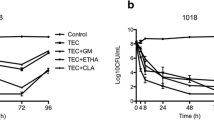Abstract
The purpose of this study was to investigate if vancomycin concentration is maintained along the lumen of dialysis catheters after 48 h of lock therapy. Each lumen of nine catheters (three subclavian and six femoral) was locked with 2,500 mg/l of vancomycin for 48 h. After that period, the content of the lumen was aspirated with three different syringes of 0.4 ml each to measure the proximal, medial and distal vancomycin concentration. Vancomycin concentration was measured using a homogeneous particle-enhanced turbidimetric inhibition immunoassay. A non-parametric ANOVA, by means of a rank transformation on the antibiotic concentration, was used to assess the influence of the catheter segment (proximal, medial and distal) and the catheter type (femoral or subclavian). A significant decrease in vancomycin concentration from proximal to distal segments was observed (p < 0.001). In addition, the vancomycin concentration in subclavian catheters was significantly higher than in femoral catheters (p < 0.001). In our study there was a decreasing gradient in vancomycin concentration from proximal to distal segments of the catheter. This may explain the failure of antibiotic lock-therapy.


Similar content being viewed by others
References
Carratala J (2002) The antibiotic-lock technique for therapy of ‘highly needed’ infected catheters. Clin Microbiol Infect 8:282–289
Ceri H, Olson ME, Stremick C, Read RR, Morck D, Buret A (1999) The Calgary Biofilm Device: new technology for rapid determination of antibiotic susceptibilities of bacterial biofilms. J Clin Microbiol 37:1771–1776
Curtin J, Cormican M, Fleming G, Keelehan J, Colleran E (2003) Linezolid compared with eperezolid, vancomycin, and gentamicin in an in vitro model of antimicrobial lock therapy for staphylococcus epidermidis central venous catheter-related biofilm infections. Antimicrob Agents Chemother 47:3145–3148
Raad I, Hanna H, Jiang Y, Dvorak T, Reitzel R, Chaiban G et al (2007) Comparative activities of daptomycin, linezolid, and tigecycline against catheter-related methicillin-resistant staphylococcus bacteremic isolates embedded in biofilm. Antimicrob Agents Chemother 51:1656–1660
Fernandez-Hidalgo N, Almirante B, Calleja R, Ruiz I, Planes AM, Rodriguez D et al (2006) Antibiotic-lock therapy for long-term intravascular catheter-related bacteraemia: results of an open, non-comparative study. J Antimicrob Chemother 57:1172–1180
Haimi-Cohen Y, Husain N, Meenan J, Karayalcin G, Lehrer M, Rubin LG (2001) Vancomycin and ceftazidime bioactivities persist for at least 2 weeks in the lumen in ports: simplifying treatment of port-associated bloodstream infections by using the antibiotic lock technique. Antimicrob Agents Chemother 45:1565–1567
Robinson JL, Tawfik G, Saxinger L, Stang L, Etches W, Lee B (2005) Stability of heparin and physical compatibility of heparin/antibiotic solutions in concentrations appropriate for antibiotic lock therapy. J Antimicrob Chemother 56:951–953
Anthony TU, Rubin LG (1999) Stability of antibiotics used for antibiotic-lock treatment of infections of implantable venous devices (ports). Antimicrob Agents Chemother 43:2074–2076
Capdevila JA, Segarra A, Planes AM, Ramirez-Arellano M, Pahissa A, Piera L et al (1993) Successful treatment of haemodialysis catheter-related sepsis without catheter removal. Nephrol Dial Transplant 8:231–234
Bailey E, Berry N, Cheesbrough JS (2002) Antimicrobial lock therapy for catheter-related bacteraemia among patients on maintenance haemodialysis. J Antimicrob Chemother 50:615–617
Berrington A, Gould FK (2001) Use of antibiotic locks to treat colonized central venous catheters. J Antimicrob Chemother 48:597–603
Rijnders BJ, Van Wijngaerden E, Vandecasteele SJ, Stas M, Peetermans WE (2005) Treatment of long-term intravascular catheter–related bacteraemia with antibiotic lock: randomized, placebo–controlled trial. J Antimicrob Chemother 55:90–94
Lee JY, Ko KS, Peck KR, Oh WS, Song JH (2006) In vitro evaluation of the antibiotic lock technique (ALT) for the treatment of catheter-related infections caused by staphylococci. J Antimicrob Chemother 57:1110–1115
Author information
Authors and Affiliations
Corresponding author
Rights and permissions
About this article
Cite this article
Soriano, A., Bregada, E., Marqués, J.M. et al. Decreasing gradient of antibiotic concentration in the lumen of catheters locked with vancomycin. Eur J Clin Microbiol Infect Dis 26, 659–661 (2007). https://doi.org/10.1007/s10096-007-0356-7
Published:
Issue Date:
DOI: https://doi.org/10.1007/s10096-007-0356-7




